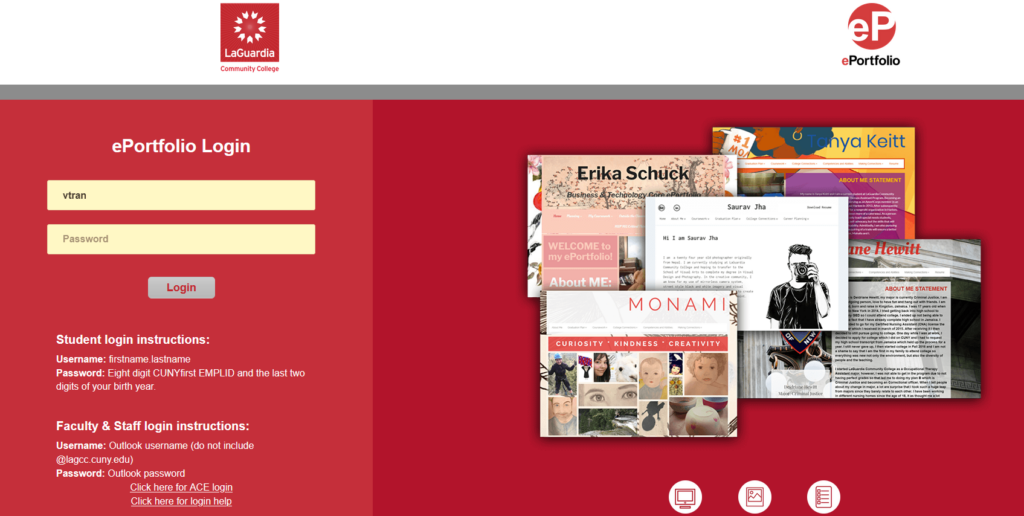
Review Contents
- Digication e-Portfolio website
- User requirements – core functionalities
- Consulting other reviews
- Key advantages and disadvantages of Digication ePortoflio
- Review Criteria
Digication e-Portfolio website
I am reviewing the LAGCC enterprise installation of the Digication e-Portfolio platform to make a preliminary exploration of the site as a portal or repository for an OER collection or as part of an OER collection. Digication is one of the companies that provide a platform for creating e-portfolios and brands its platform as “e-Portfolio”. The platform itself is not free but LAGCC provides it free to faculty, students and staff. Some of students’ tech fee pay for student mentors. Free sites for creating e-portfolios or websites include Google Sites and WordPress. I am also comparing and contrasting with features that are available in CUNY Academic Commons, as this is another platform to consider.
My review is of the current 2020/21 Digication version and not the classic version. This is a work in progress and the reader’s experience and comments and help in completing this review will be much appreciated. My conclusion is that Digication is not as versatile as CUNY Academic Commons for developing an OER portal or repository, or even a eportfolio.
LAGCC ePortoflio login site: https://lagcc-cuny.digication.com/app/ or https://apps.laguardia.edu/eportfoliosso/
Digication website: https://www.digication.com/

User requirements – core functionalities
At minimum, the repository should include these core functions:
- Import, embed, or upload many different types of content or file formts
- View contents on site or provide links to external resources
- Download content
- Search and browse easily and quickly. Some of this will depend on how the user organize and design the website, but the robustness of the search engine and amount and types of metadata that can be entered will be assessed.
- Support/help and documentation
- Simple and user friendly interface
- Fast Speed
- Media Library for contents, preferably with sub folders
- RSS
- Forms
Consulting other reviews
I started by contacting the ePorfolio office at LaGuardia for specifications, user requirements, user studies, review or evaluation. I was told there was none. I asked how the site compared with the CUNY Academic Commons but was told that the administrator was unfamiliar with Academic Commons. I also contacted the Center for Teaching and Learning and was told that they had not done a review. I searched the library and literature database and website for a review of Digication ePortfolio and found a few articles and some simple criteria. Most of it was directed at eportfolio, so not as useful for assessing the use of the platform as a repository.
I had first examined Digication in November 2019 to determine whether it would be a good platform for the NSD OER portal, and decided it was not as suitable and flexible as the CUNY Academic Commons. There are some aspects of ePortoflio that I find simpler, like creating page hierarchy and being able to customize font and color and tables. Both ePortfolio and Academic Commons are comparable and they can be used as a repository only to organize links to external resources and to contain a small collection of core contents. Both sites require, however, a significant amount of planning and customization to create the platform interface and user friendly browsing and searching experience. Its use will probably need to be supplemented with a permanent cloud storage. The site designer will have to create the necessary organization and navigation for browsing and searching. I would need more information on searching capabilities of Digication ePortfolio.
A platform review is complicated because it also has to be assessed from three perspectives: Administrator, Site creator and Users. The users themselves also need to be differentiated faculty (full time, adjuncts)), students (enrolled, non-enrolled), and the public (members and non-members). From an administrator or site creator perspective, my main criteria are contents that can be included, speed, storage, templates and customization, browsing/searching capability, sharing/security, sustainability, interoperability, and local support. Different user requirements and user studies of content contributor and users (faculty, students, and the public) will need to supplement this review. User contents also affect the look and feel, navigation, and usability. A decision will need to be made as to whether only the administrator add content or the user can add content. This will have an impact on the design of the site.
Key advantages and disadvantages of Digication ePortoflio
Three main advantages of using Digicaction ePortfolio include:
- Is an existing platform that many students and faculty at LAGCC already use or are familiar with and has no additional cost. All first year students are introduced to ePortfolio and can easily create an account with their regular LAGCC login. Many faculty in humanities are already using it and thus it would not require faculty or students to learn a new platform. ePortfolio is used in college assessment.
- Local support at LAGCC. There is a team of nine staff and numerous student mentors.
- Many types of contents can be uploaded or created on the site and creating and customizing pages is fairly easy and flexible. File upload size is 1 GB and storage is unlimited.
Four main disadvantages that need further exploring:
- Library. For both ePortfolio and Academic Commons, the library does not allow for syncing nor file organization, such a cloud storage like Google Drive, OneDrive or Box.com. There is no built in catalog and metadata for managing, organizing, collating, and retrieving.
- Management/administration. It is not clear who is an administrator or what administrative rights the site creator has.
- Search capacity does not seem to be as robust as the WordPress search tool and is not like Google.
- Lack of compliance with accessibility standards. This is a key weakness, but some of this might be due to the template design. There is no indication that any of the theme or template is accessible ready, which is an option that WordPress provides.
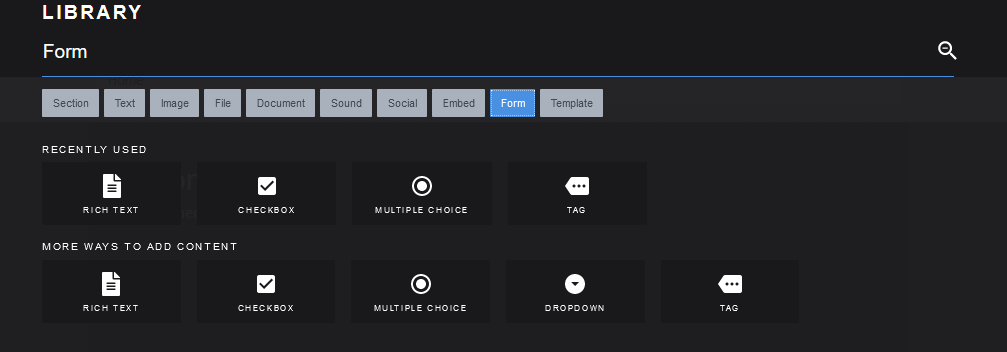
Review Criteria
The following criteria were used to review Digication ePortfolio:
- Content and format
- Creating or uploading content
- Site file storage
- Interoperability
- Device responsive
- Integration
- Cloning and templates
- Metadata
- Structure, navigation and usability
- User customization
- User interaction/feedback
- Help and support
- Advertisement
- Speed
- Learning curve
- Collaboration
- Copyright and data ownership
- Accessibility
- Hosting
- Cost
- Alumni access
- Sustainability
- Permission and sharing
- Updates and security
- Data privacy – tracking
Content and format
My assessment is that overall the platform is very good to excellent. You can upload, embed and link to many different media types and resources. There are also equation and forms.
Creating or uploading content
Content that can be uploaded or created include:
- Videos (from YouTube, Google Videos, etc.)
- Audio recording.
- Cloud storage (GitHub, Google, Box.com)
- Images (many format) as well as URLs and will be automatically resized
- PDFs.
- Microsoft Office files (Word, Excel, PPTs, etc.)
- Can upload from “previous uploaded” and from external sources.
- Create links, tables, text, forms (checkbox, multiple choice, dropdown, tag) on the site
- Embed videos, links to webpages (to get a snippet of it)
- Inserts and opens Equation Editor to type equations into text boxes using LaTeX, MathML or ASCllmath syntax.
- Take pictures, record video, record audio with a webcam and microphone on your device
User can an drag and drop to upload files.
Can upload multiple files at once
- Uploading multiple files will create a gallery.
- Upload size is limited to no more than 1 GB (this is more than CUNY Academic Commons 40MB).
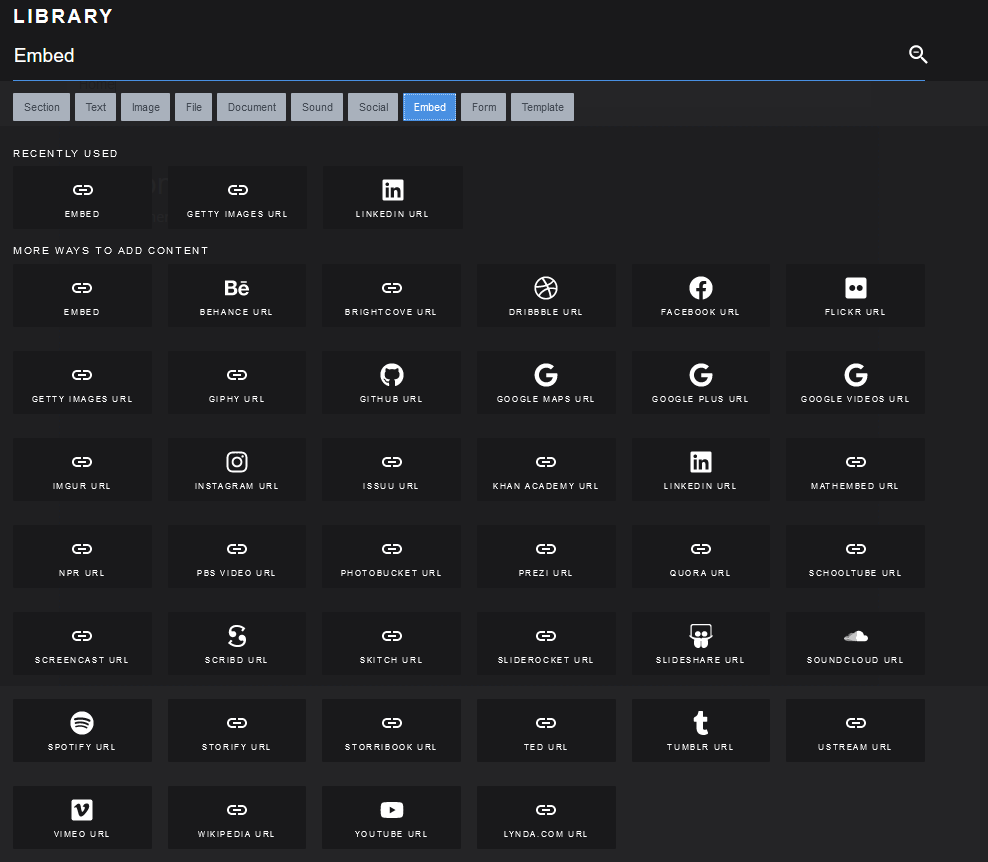

Output and Download format
The entire site can be downloaded as an HTML folder, which can be opened in any browser on a local computer
Applications on the platform
- Audio can be listened to and videos can be embedded and watched on the platform. PDFs can read.
- There is no e-book reader nor e-book platform. An e-book could be created (like Pressbooks), but this would take a lot of time and it would be better to use a resource for that. The e-book file could be linked to or uploaded to be downloaded.
Site storage is unlimited
One strong feature is the unlimited file storage However, files above 1GB cannot be stored in the library because there is a 1 GB file size upload limit.
Interoperability – poor
The platform software is not open-source. Contents can be downloaded. The “styling” provided by Digication does not import to other sites.
Device responsive – excellent
The platform is device responsive. The default design scales to desktop, tablet and mobile phone.
Integration – good
Files can be imported from Microsoft Office, Google Drive, Box.com. A link to the site can be included in any website, including Blackboard.
Cloning and templates – good for courses and average for eportfolio
LAGCC creates e-portfolio and course templates. Both are useful for customization or to use as is for those who do not want to customize.
- Users can share their site as a template within CUNY or beyond.
- Users can clone their own site.
- There are five types of templates:
- Featured Templates – Templates designated as “Featured Templates” are prioritized in the list of available templates that users see when creating an ePortfolio.
- Templates Pending Admin Approval – Templates that have been set as “School Wide” by the creator, but have yet to be approved by an admin
- Course Templates – Private templates that have been shared with the Faculty and Students of a particular course.
- School Wide Templates – Templates that are available to all users at a school. Can be created by any user, but must be approved by an administrator before it will be available.
- Digication Templates – Templates created by Digication which are shared with all schools.
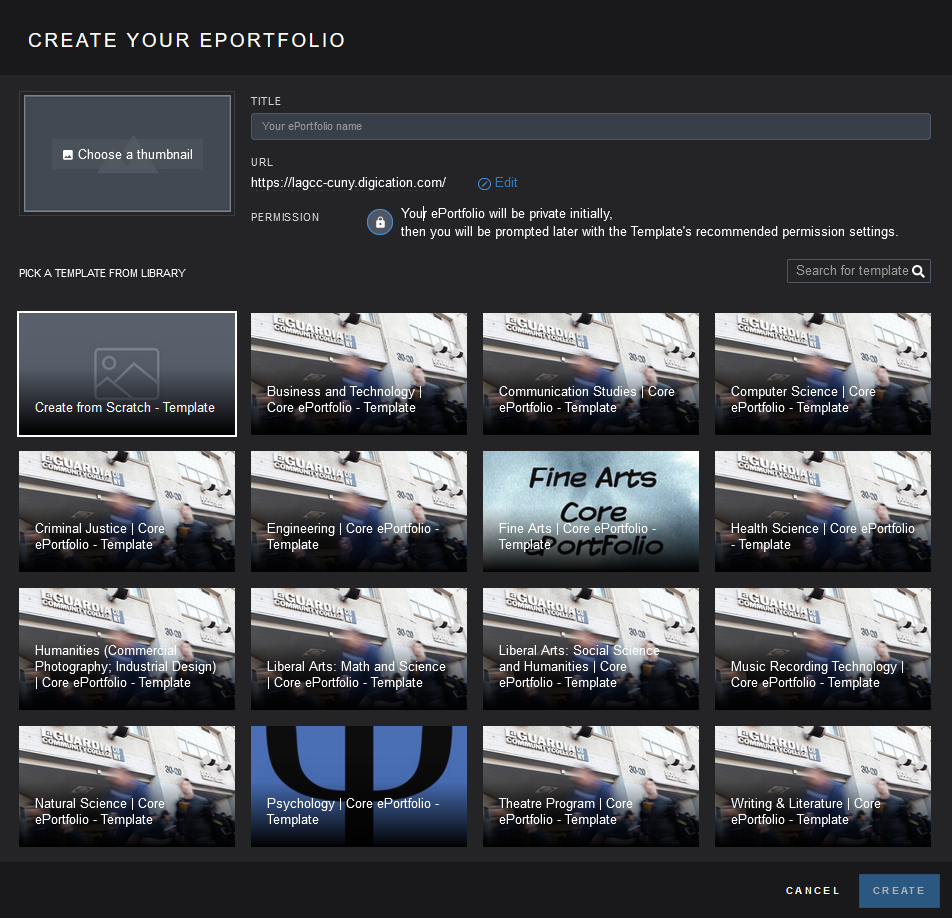
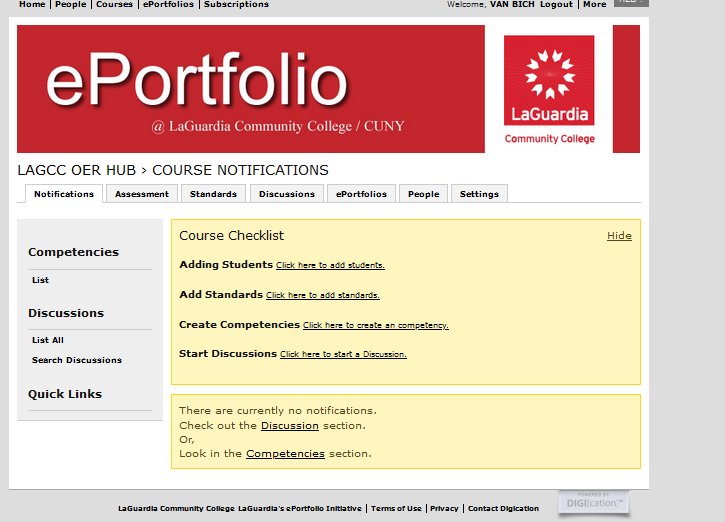
Metadata
There is no metadata support like CUNY Academic Works (Bepress Digital Commons).
Structure, Navigation and Usability– very user friendly
The platform itself is user-friendly to set up the pages. Administrative and settings are well organized. Settings are on left side. Organizing page hierarchy is particularly easy. The usability, however, will also depend on how the site is set up by the content creator, which was not assessed.
| Usability criteria | review comments |
|---|---|
| User interface/GUI | Simple and user friendly for creating an eportfolio and course page, especially with drag and drop. Creating a repository will take more designing and customization. |
| Home page length/Database length | A blank page is about a screen size. Based on template. Users will have to create navigation markers for long pages. |
| Style, Font size and Color | I don’t like the default black colored background, but others might. |
| Sitemap | Don’t know. The site creator can probably create one. |
| Organization and arrangement of contents | Pages are organized by sections (slides). Sections include the background and content within and can be easily resized and moved around. (This feature is much more user friendly than Academic Commons). Sections hold content such as text boxes (rich text), uploaded files or photos. Contents are displayed as modules that can be customized. Each section has a unique background and having multiple sections can help visually break up for a page. Pages uses layering, so the user will need to understand this. Uses drag and drop |
| Searching features | Don’t know. There is little information on the search engine. |
| Home page search box | Yes, but I think it searches for the portfolio names |
| Key word search, Search specificity | Don’t know. Maybe exact searching only. |
| Free text search with relevance ranking | Don’t know. |
| Effect of misspelling | Does not seem to automatically correct misspelling |
| Browsing features | |
| Instructions on how to search/use website/help | This will depend on site creator. |
| Navigation | |
| navigation bars and/or menus, bread crumbs | There is a top menu where pages can be organized by hierarchy and can be hidden or shown and ordered. This is done by drag and drop and is easy. |
| Moving around website; /links work | This will depend on site creator, but the platform itself is fine. |
| No errors/dead links | This will depend on site creator, but the platform itself is fine. |
| Auto saving | While editing, changes are automatically saved. Changes however are not visible to others until they are published. |
User customization is very good to excellent
| Customization criteria | review comments |
|---|---|
| Template, theme, site | Users can start from scratch or use a template and modify it. |
| Styles, Alignment, Fonts, Size and Color | Very easy to use. Can change font type, size, and color and background color and opacity for any heading, font, paragraph and content, as well as setting and applying a style to an entire module, section or site (ePortoflio). (This aspect is similar to the classic editor in WordPress). Has heading styles, bullet and number lists, link, quote and equation styles. Tables are easy to format and to change color, padding and font size, border thickness. There is an option to revert to default styles. You can select styles for Headings, Quotes, Equations, Links, Bullet Lists, and Number Lists. Overall more flexible than Academic Commons. |
| Equation | There is an equation editor. |
| Guide/direct user based on information need | Don’t think so |
| History of searches | Don’t know |
| Save searches | Don’t know |
| RSS, subscription | Yes, to site. Need to explore this more to see if user can subscribe to particular OER once content is added. |
| Build a “My collection” | Yes |
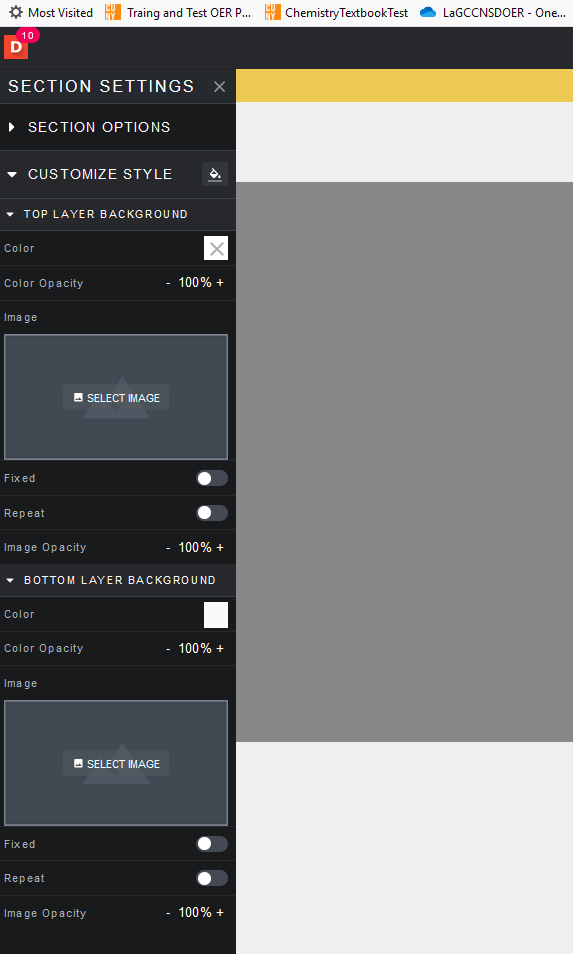
User interaction and feedback – average
| type of user interaction | review comments |
|---|---|
| Ask a question | Yes |
| Comment-feedback | Yes |
| Frequent Q&As | Yes |
| Online discussion/forum | Don’t know |
| Satisfaction survey | Don’t know |
Help and support is very good
| Help and support criteria | review comments |
|---|---|
| Help and Support | Very good to Excellent from LaGuardia. Good from Digication. There is individualized support, scheduled workshops, tutorial and online help materials. A one or two page “cheat sheet” is needed. There is a link to Digication help in the site’s settings. |
| Overview video | Overview video is basic and adequate |
| Overview guide/user manual | Content is online by topic and divided by students, faculty and administrators. I would prefer to have one guide, and a downloadable manual for me to get an overall understanding of the site. I do not find any third party manual or user guides for Digbication. Student online guide. ePortfolio Faculty and Staff Guide needs improvement. |
Speed, Learning Curve, Copyright, and Advertisement
| Speed and copyright | review assessment |
|---|---|
| Advertisement or Third Party solicitations | None on the site. |
| Speed (Moving around, search, upload, download, etc.) | Very good. |
| Expertise and Learning Curve | Low learning curve for contents like an e-portfolio and course page as there are templates. Can get started in minutes. Customization and ensuring accessibility will take moderate amount of time investment. |
| Collaboration | Yes. Can authorize others to work on a site, be a member. |
| Copyright and data ownership | Digication does not claim ownership of contents contributed by users. Users must only post content that they have a right to post. Users must indemnify Digication for violations if Digication is assessed liable. This is standard. |
| User set Creative Commons or Open license | Need to check |
Accessibility needs improvement
Overall, accessibility is poor. Many student projects are not attentive to accessibility issues. The templates are not fully accessibility ready.
| Accessibility criteria | review comments |
|---|---|
| Compliance with accessibility standards | 508 compliance and W3C web content accessibility guidelines are not met. |
| Device-Compatible | Yes, for desktop, mobile and table. Screen will resize to fit device. |
| Browser compatible | Yes, it is compatible for Firefox, Safari, Internet Explorer, and Chrome |
| Log-in requirement | LAGCC email is required to login to create. Users can be invited to a site and can access via a link without registering. |
| Language easy to understand | Yes. |
| Contact information | Yes, for LaGuardia and Digication (at bottom), for problems. |
| Other languages | Don’t know |
Hosting, Cost and Alumni Access
| COST AND ACCESS CRITERIA | REVIEW COMMENTS |
|---|---|
| Hosting | Hosted by Digication. LAGCC pays enterprise license for hosting and platform use. |
| Cost | Unknown amount for LaGuardia enterprise version. Indirect cost for LAGCC students via student technology fee. Otherwise free for LAGCC users and those they invite. |
| LaGuardia pays for the subscription/access license. Amount is unknown. LAGCC has been receiving grants but it is unknown if there are grants supporting it now. The budget is unknown. However, a portion of student technology fees has been approved to pay for the student mentors. Faculty, students and those authorized to access do not have to pay to access or use content. Per its website, the price typically ranges from $5 to $14 per account per year depending on the number of accounts purchased. Unlimited faculty, staff, administrator or alumni accounts are provided at no additional cost for the enterprise account. Students can buy an account for $20/year. | |
| Alumni access | As long as LAGCC has an agreement with Digication, Alumni can retain access to ePortfolio free of charge using their personal email accounts. |
Sustainability
The e-portfolio concept is highly sustainable and the use of Digication platform itself seems sustainable.
| Sustainability | review comments |
|---|---|
| Company – Due diligence | The company was founded in 2002 by two Rhodes Design school graduates. There is not much information on Digication aside from its website and Wikipedia entry and a few news articles. https://www.digication.com/about.html. It is a for-profit company, incorporated in Delaware and registered to do business in Rhodes Island. Early on it sometimes missed the annual filing, but since 2014, it has filed annual reports each year in Rhodes Island. There are two co-owners and directors and it seems tightly held by these two. It seems to specialize in “e-Portfolio” and has a large number of users for this. |
| Longevity at LAGCC | The e-portfolio concept has been implemented at LAGCC since 2002, first with a platform created by an IT professor. In 2003, BlackBoard Concord Master was selected. It is not clear when the licensing agreement with Digication started. |
| Mandate or policy | Yes, there seems to be a policy or practice for e-portfolio and its use in assessment |
| Archives | So long as LAGCC has a license agreement, content is retained unless the user deletes the account. |
| Tracking visits | Don’t know. Not sure how visits can be tracked per site. |
| Volume of users | Don’t know. LaGuardia previous reported about 5000 users per year. All first year students are reported to be exposed to it. On the site, there is a list of all users by emails, and users can be searched. |
Permission and sharing is good
Permission can be for self only, for a specific group, persons, courses, within the school, or to the public. It does not seem to support page password protection.
- Share settings include admin (view, edit, publish and access settings), publisher (view, edit, publish), editor (view and edit but not publish) and viewer (view only)
- The published view mode allows the creator to see what the public or those with access can see.
- I don’t know if pages can be password protected. Searching the Digication website does not provide an answer other that it did not as of 2016. (CUNY Academic Commons/Word Press allows page password protection)
Updates and Security
Digication provides updates, upgrades and security. LaGuardia team does top level administration and authentication. There has not been any reported security breach.
I have not checked if ePortfolio and meets IT approved cloud storage and student data policies.
Data Privacy and Tracking
There is a standard privacy clause. Policy states noo selling of data to third party. However, information can be used for site improvements, including providing information to third party.
Author: Van Bich Thi Tran (5/15/2021)



